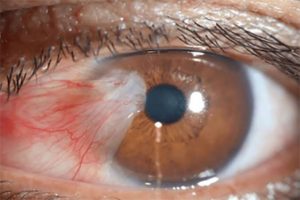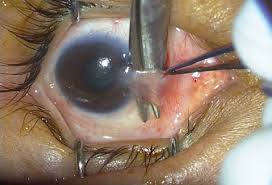Pterygium is a benign (non-cancerous) growth of a fleshy pinkish mass of thickened conjunctiva that invades the cornea. It is usually in the nasal part of the eye and triangular in shape. It causes the sensation of a foreign object in the eye. It is not harmful but causes discomfort or irritation and can affect vision. Pterygium grows on the outer surface of the eyes unlike cataract that affects the lens inside the eyes.

Causes:
The cause is unknown but risk factors are;
. Exposure to excessive ultraviolet light (from sunlight)
. Environmental irritation (wind, dust, chemicals, air pollution) and
. Genetic (passed to offspring)
Prevention
Using sunglasses to protect the eyes from UV light, dust particles etc. The use of large hats to provide shade from the sun
Symptoms
. Blurred vision
. Eye irritation; the feeling of dryness/ itchiness or pain in the eye
. Redness; Occurs when the blood vessels in the eye become swollen or irritation
Diagnosis
Pterygium is diagnosed using slit lamp (a microscope with bright light used when examining the eye)
Treatment
When there is discomfort/ irritation of the eye, eye drops or ointment containing corticosteroids will be prescribed to reduce inflammation.
Surgery is usually recommended in severe cases.

Diagram: performing surgery on pterygium
Complications
Recurrence of pterygium is common.
Image credit:
Searchlight
jeos.eg.net

Pharm. Fatima Ajide J. is a current pharmacology student at Olabisi Onabanjo University.
She has a passion in researching about the interaction between organs and drugs (i. e. the Pharmacodynamic and Pharmacokinetics).
A practicing Muslim and hobbies are tourism, reading and Research.

